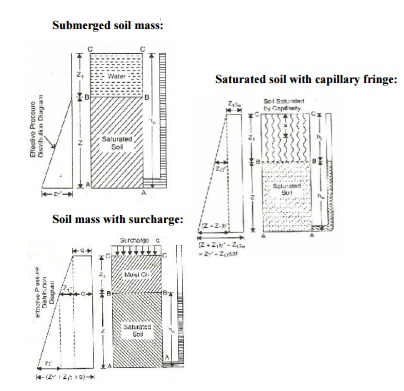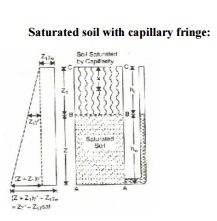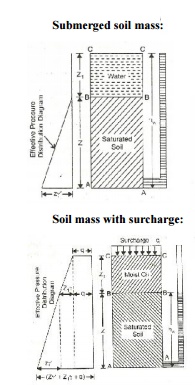Chapter: Civil : Soil Mechanics -Soil Water And Water Flow
Effective Stress Concepts In Soil

EFFECTIVE STRESS CONCEPTS IN SOIL
At any plane in a soil mass, the
total stress or unit pressure ? is the total load per
unit area. This pressure may be due to i) self weight of soil ii) over burden
on the soil.
The total pressure consists of
two distinct components: inter granular pressure or effective pressure
and the neutral pressure or pore pressure. Effective pressure ?' is the
pressure transmitted from particle through their point of contact
through the soil mass above the plane.
Such a
pressure, also termed as inter granular pressure, is effective in decreasing
the voids ratio of the soil mass and in mobilizing its shear strength. The
neutral pressure or the pore water pressure or pore pressure is the pressure
transmitted through the pore fluid.
Therefore, this pressure is also
called neutral pressure (u). Since the total vertical pressure at any plane is
equal to the sum of the effective pressure and pore water pressure we have,
s = s ' + u
1
Submerged soil mass:
2 Soil
mass with surcharge:
When the water level in the
reservoir is corresponding to the flood level (H.F.L), the portion to the u/s
of the dam will be saturated. The water level in the u/s pervious shell will be
practically the same as the H.F>L. Due to capillarity, water will rise
through a height hc. If the top of the core is situated at a height y< hc
above the H.F.L, , the capillary forces ill pull the water in descending part
of the earth dam, and will slowly empty it. This process is known as capillary
siphoning.
4 Formation of meniscus:
When a solid or hollow tube, wet
with water is partly inserted vertically in water, the molecules, due to
attraction between the molecules of water and the material, climb the solid
surface forming a curved meniscus adjacent to the walls of the tube or rod.

5
Saturated soil with capillary fringe:

6 Soil Shrinkage Characteristics in Swelling Soils
Objectives
Understand
soil swelling and shrinkage mechanisms, and the development of desiccation
cracks;
Distinguish between soils having different magnitude of
swelling, as well as the consequences on soil structural behaviour; Know
methods to characterize soil swell/shrink potential;
Construct soil shrinkage curves, and derive
shrinkage indices, as well to apply them to assess soil management effects.
7 Bulking
Of Sand:
As the moisture content of a fixed weight of sand increases,
the volume also increases--up to a point. This is known as "bulking".
Bulking of loose, moist sand in the increase in its volume as
compared to dry sand. Bulking is a well known phenomenon particularly in the
trade of aggregate for proportioning of concrete. This phenomenon has been
known since 1892 when it is was investigated by Feret at French school of
Bridges and Roads.
This bulking phenomenon of sand is explained by moisture hulls
or films which surround the sand particles. The contact moisture films,
adsorbed to the sand particles by moisture surface tension forces, tend to cause the sand
particles to occupy a larger volume as compared to their dry state. Generally
bulking of sand increases as the particle size of sand decreases. This is
because of the increase in the specific surface area of the sand. Upon further
subsequent increase in moisture content in sand, when a maximum increase in
bulking volume is attained, bulking in its turn decreases, and upon the
inundation of the sand the surface tension forces are neutralized, and most of
the bulking, in such a case vanishes. As a consequence, the sand particles now
rearrange themselves into a denser packing.
Effect of
bulking on sand
Bulking of sand in a loose state of packing decreases the
bearing capacity of sand considerably. In compacting sandy soils, low densities
are usually achieved because of bulking.
Related Topics